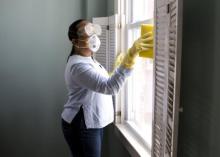Cleaning and Sanitizing With Bleach after an Emergency
Cleaning and sanitizing your household after an emergency is important to help prevent the spread of illness and disease. For additional information, contact your local health department.
Using cleaning and sanitizing products
- Wash surfaces with soap and warm, clean water to remove dirt and debris.
- Sanitize surfaces with a bleach solution (see below for instructions to make a bleach solution).
It is critical to read and follow the safety instructions on any product you use. Below are important safety guidelines when using sanitizing products:
- Never mix bleach with ammonia or any other cleaner. This creates toxic gases that are dangerous and can cause serious injury. Ammonia is commonly found in window cleaners. Check the cleaner bottle to see if it contains ammonia.
- Wear rubber boots, gloves, and eye protection.
- If using bleach mixtures indoors, open windows and doors to allow fresh air to enter.
Cleaning and sanitizing with bleach
Use regular unscented 5% household bleach and follow the instructions in the chart below.
Recommendations for cleaning and sanitizing various surfaces with bleach and water
| Area or Item to be Cleaned | Bleach Amount | Water Amount | Cleaning Steps |
|---|---|---|---|
| Food surfaces that may have touched flood water (Examples: countertops, cups and plates, flatware)
Note: Throw away wooden cutting boards, baby bottle nipples, infant toys, and pacifiers |
1 teaspoon | 1 gallon |
|
| Food cans that are not bulging, open, or damaged | 1 cup | 5 gallons |
|
| Area or Item to be Cleaned | Bleach Amount | Water Amount | Cleaning Steps |
|---|---|---|---|
| Mold growth on hard surfaces (Examples: floors, walls, windows, stoves, sinks, certain toys, countertops, flatware, plates, and tools) | 1 cup | 1 gallon |
|
| Area or Item to be Cleaned | Bleach Amount | Water Amount | Cleaning Steps |
|---|---|---|---|
| Surfaces that do not soak up water and that may have touched floodwater (Examples: floors, stoves, sinks, certain toys, countertops, and tools) | 1 cup | 5 gallons |
|
Other Useful Cleaning and Sanitizing Information may be found in the following links:


